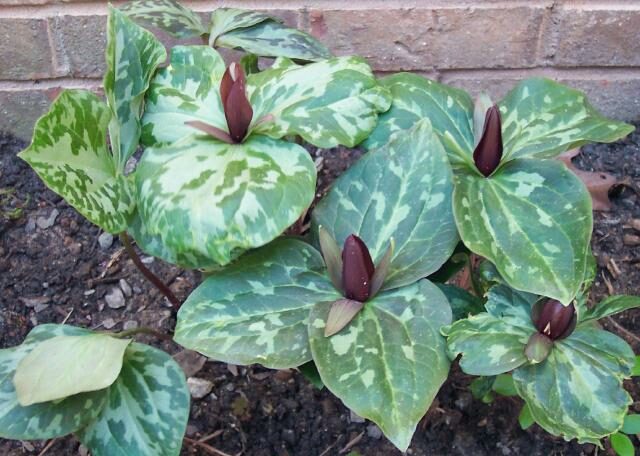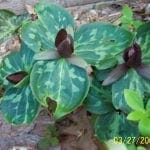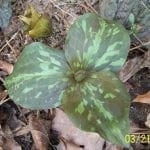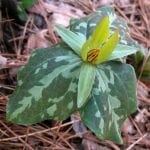- Flower
- Flower
- Emerging in spring
- Spring, flower not open
- Odd color form of Trillium cuneatum
Scientific Name:
Trillium cuneatum
Common Name:
Toadshade Trillium
Scientific Name Pronounciation:
TRIL-ee-um kew-nee-AH-tum
Plant Type:
Perennial
Plant Hardiness Zones:
5-9
Plant Hardiness Zone(s):
Usual Size:
6-20 in. H X 8-12 in. W
Flower:
3 generally erect elliptic-obovate petals, typically 1.5-2.5 in. long (sometimes to 4 in.) and 0.5-1 in. wide, widest at or just above the middle; maroon/purple, bronze, green, or yellow-green; borne directly on the leaves (sessile); sometimes with faint fruity or spicy fragrance; 3 spreading sepals, usually slightly shorter and narrower than the petals and variably green to purple streaked; 2 whorls of 3 erect stamens.
Bloom Time Notes:
Spring
Leaf:
3 leaves whorled at summit of green to purple stems; typically richly marbled with light to dark shades of green to near black; occasionally uniform light silver-green or dark green; broadly ovate, 3-8 in. long and 3-5 in. wide; usually widest below middle; pointed at the end.
Fruit:
Ovoid, to vase shaped; mealy or pulpy; green or purple streaked; pollinated plants may contain several dozen or more seeds.
Wildlife:
Ants carry the seeds to different places, attracted by the fleshy elaiosome attached to it.
Natural Habitat:
Coves and slopes in rich, deciduous woodlands, near streams, flood plains in some parts of its widespread range.
Propagation:
Collect seed pods when they begin to soften in late June to early July and squeeze out the greenish/light brown seeds; sow freshly harvested (within 5 days), and barely cover, after soaking for 15 minutes in 3% hydrogen peroxide as obtained from drug stores; do not allow seeds to dry out; soaking makes the white elaisome attached to the seed sterile and unpalatable to ants, which may otherwise carry the seeds away from the desired planting area; if using a planting bed, a thin layer of Permatil or chicken grit at the surface may help prevent damping off; seeds often require two years to sprout a single leaf, forming all three leaves in subsequent years, with flowering after 5 to 7 years; more rapid vegetative propagation is possible by debudding, scoring, or cutting the rhizomes.
Bloom Time:
Sun or Shade:
Companion Plants:
Cultural Notes:
Toadshade Trillium (Trillium cuneatum) grows in moist shade under deciduous trees or large shrubs in well-drained, humusy soil; can tolerate, or even prefer a dry, summer dormant period once established; addition of rotted leaves as a top dressing can be beneficial; spring shoot buds are usually just below the forest litter; may be planted shallower than found in the wild; plant among ferns, bloodroot, rue anemone, etc.
Outstanding leaf color and patterns; flower is long lasting, fading as it ages; may be found in spectacular colonies; vigorous; the name trillium comes from the Greek for three; cuneate (wedge-shaped) refers to the shape of the bottom of the petal.
Occasionally green forms will occur; they are distinguished from the similar Trillium luteum by lack of pleasant fragrance.
Transplant tips: Rhizomes, several inches deep, with stems and roots attached, can be dug and saved in buckets or plastic bags with minimal or no earth attached if watered and kept moist until planted; can be held for more than a week if necessary; digging with clumps of earth may reduce transplant stress; if stems break, plant will likely live but lose vigor and require several years to recover.
Other Common Names: Whippoorwill Toadshade, Sessile Trillium, Sweet Betsy, Bloody Butcher, Cuneate Trillium, Purple/Large Toadshade






